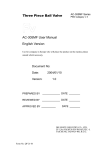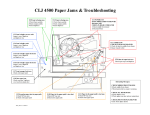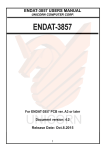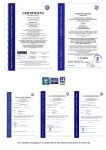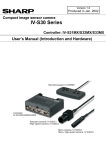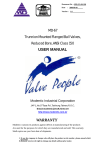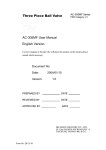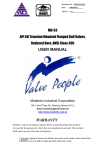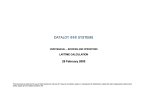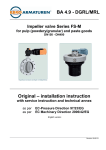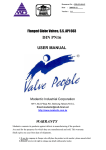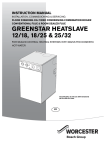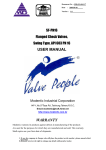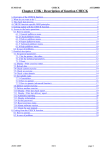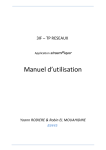Download 3-Piece Ball
Transcript
Three Piece Ball Valve AF35(L370MF) Series PED Category I II User Manual (Operating & Maintenance instructions) Document No SM23 Date 2004/11/5 Version 1.0 PREPARED BY REVIEWED BY APPROVED BY Exclusive distributor: DATE 2004/8/2 DATE 2004/8/2 DATE 2004/8/2 Contents 1. General Precautions Page- 2~3 2. Product Description Page- 3~4 3. Design Specification Page- 4 4. Pressure Temperature Ratings Page- 5 5. Delivery Condition and Storage Page- 5 6. Installation and Operation Page- 5~8 7. Put into service Page- 8 8. Dangers of inappropriate use Page- 8 9. Maintenance Page- 8~10 10. Torque Data Page- 10 11. Corrosion Data Page- 10 1 1. General Precautions a. Material Selection: The possibility of material deterioration in service and the need for periodic inspections is dependant on the line medium. Carbide phase conversion to graphite, oxidation of ferrite materials, decrease in ductility of carbon steels at low temperature (even in applications above –29 Deg C) are among those items. If information about corrosion data is available; the user is advised to refer to it to determine the suitability of material for the application. b. Pressure-Temperature rating: The stated Pressure -Temperature rating is based on zero pressure at ambient temperature. Please refer to P & T rating Section 4 for working conditions. The allowable temperature is between –20 and +180 Deg C. Do not exceed this range. c. Thermal expansion: When the ball valve is in the closed condition, it is likely that the cavity within the valve body will be filled with medium. If this medium is not released and the valve is subject to a temperature increase, excessive pressure may build up causing seal failure. To overcome this, our products have self-relieving seats. The user is, however, advised not to rely on this feature and to ensure that the pipeline design, installation and operating procedures are adequate to overcome such potential shortcomings. d. Static electricity The ball valves are provided with anti-static devices on ball-stem-body. When service conditions require electrical continuity to prevent static discharge, the user is responsible for specifying static grounding. e. Firesafe condition: Generally, the application of the valve shall comply with the PressureTemperature rating range. If the risk of fire is a major issue, user is recommended to select our fire-safe products, which have API-607 approval. Contact the valve distributor or manufacturer for details. f. Liquids with high fluid velocity: When soft-seated ball valves are to be operated frequently on liquids with very high velocity, a check should be made with the distributor or manufacturer for appropriate advice to minimize the possibility of seat deformation, especially when they are highly pressurized on high-temperature line. g. Throttling service: Ball valves are not recommended for throttling service, as both the leading edge of the ball and the seats can be damaged, causing leakage. High fluid velocity or the presence of solid particles in suspension will further reduce seat life h. Do not open the bonnet or cap when the valve is under pressure. The valve is not equipped with pressure access device. The valve should only be opened after depressurisation. i. Do not touch the surface of valve on high temperature applications. 2 j. Not allowed for unstable fluid, otherwise specified with catogory III in Declaration of conformity or/and in this user manual. The handle has a locking feature to avoid unauthorised operation 2. Product Description 2.1 Feature a. STANDARD type, FULL BORE ball valve. b. Blowout proof stem. c. Anti-static devices for ball-stem-body. d. Heavy-duty body & end cap construction with traceable heat number. e. Pressure balance hole in ball slot. f. Self-relieving seat to prevent excess pressure built up. g. Lock design on the handle is optional requirement. 2.2 Product specification The scopes of product specifications are as following Item No. Nominal Pressure Art.3 Para3 of PED No CE Marking Category II AF35 (L370MF) PN 138 DN 8 10 15 20 25 DN 32 40 50 2.3 Material of construction No. Part Name 1 BODY 2 END CAP 3 BALL 4 SEAT 5 GASKET 6 THRUST WASHER 7 STEM PACKING 8 GLAND 9 BELLEVILLE WASHER 10 STEM 11 PACKING NUT 12 HANDLE WASHER 13 HANDLE NUT 14 BOLT 15 HANDLE 16 HANDLE COVER 17 LOCK SADDLE 18 O-RING 19 STOP BOLT 20 ANTI-STATIC DEVICE Stainless Steel Carbon Steel EN 10213-4 1.4408 EN 10213-2 1.0619 EN 10213-4 1.4408 EN 10213-2 1.0619 EN 10213-4 1.4408 PTFE GRAPHITE GRAPHITE GRAPHITE EN 10213-4 1.4308 DIN 1.4310 EN 10213-4 1.4408 EN 10213-4 1.4308 EN 10213-4 1.4308 EN 10213-4 1.4308 EN 10213-4 1.4308 DIN 1.1191 EN 10213-4 1.4308 ZINC PLATED STEEL PVC EN 10213-4 1.4308 VITON EN 10213-4 1.4308 DIN 1.1191 EN 10213-4 1.4308 3 2.4 Common dimensions 3. Design Specification Items Standards/Codes Standards of Design (P-T rating) prEN 12516-1 ASME/ANSI B16.34 Testing EN 12266-1 ASME/ANSI B16.34 Mounting Pad ISO 5211 Material of Casting (Body, Cap, Ball) EN 10213-4 /1.4408 ASTM A351, A216 Bolt and Nut ISO 3506 (A2-70) ASTM A193, A194 (B8) 4 4. Pressure Temperature Ratings WORK PRESSURE IN BAR FE PT WORK PRESSURE IN PSIG The pressure-temperature rating of ball valves is determined not only by the body materials but also by the seal and trim combinations all of which are determined by the characteristics of the service mediums and conditions. The following general rating charts for non-shock fluid service for floating ball valves distinguished by sizes and seating materials. Please refer to section 1, General Precaution. SERVICE TEMPERATURE 5. Delivery Condition and Storage Valves are shipped in the open condition and should always be stored that way. For incoming QC, the following should be checked: a. Packing condition: Is there any damaged during the transportation. b. The tightness of all external bolts should be checked. c. Valves should be stored indoors, preferably in a climate-controlled environment 6. Installation and Operation 6.1 Handling During installation, you must follow the procedure to handle both sides of the bodies. If using mechanical handling, ensure the equipment is of a suitable rating 6.2 Cleaning Regardless of the storage environment, valves should be checked for cleanliness 5 before use. If necessary, clean before installation. Clean the valves by water, compressed air, or steam. Valves should first be cleaned in the fully-open position and then, if further cleaning is considered necessary, in the half-open position 6.3 Valve Installation a. Direction Valves are bi-directional, unless marked to the contrary. b. Position Valves are not designed to be self-supporting, nor are they designed to be structural; they should be properly supported. c. Fittings Select the correct specification of bolts to fasten the flange with pipeline. The following table shows the fitting information. Nominal Pipe Size Dia of Bolt Holes Diameter of Bolts DN 8 ¼” 9 mm - 8 hole M8 DN 10 3/8” 9 mm - 8 hole M8 DN 15 ½” 9 mm - 8 hole M8 DN 20 ¾” 9 mm - 8 hole M8 DN 25 1” 9 mm - 8 hole M8 DN 32 1.1/4” 11 mm – 8 hole M 10 DN 40 1.1/2” 13 mm -12 hole M 12 DN 50 2” 13 mm -12 hole M 12 Flange bolting should be conducted in accordance with sound engineering practice, spreading the load evenly and equally. See the drawings below for the order of bolts installation. Round type 8 bolts Round type 12 bolts 6 Torque data are provided in table as following table for information. For A2 screws Tightening torque (N-m) 70 80 Thread diameter Friction coefficient 50 M8 0.2 10.1 21.4 28.7 M10 0.2 20.3 44.0 58.0 M12 0.2 34.8 74.0 100.0 d. Body hydrostatic test Before delivery, valves are tested 1.5 times the allowable pressure at ambient temperature in the half-open position. Pipeline testing should not exceed this maximum 6.4 Actuator installation The ball valves are provided with ISO 5211 mounting flanges. Following is the flange type against sizes of the ball valves. SIZE Mounting Pad DN 8 ¼” F04 DN 10 3/8” F04 DN 15 ½” F04 DN20 ¾” F04 – F05 DN25 1” F04 – F05 DN32 1.1/4” F07 DN40 1.1/4” F07 DN50 2” F07 Actuator sizing depends on operating conditions but maximum power should not exceed the maximum allowable operating torque of the valve Excess power will damage the valve and possibly associated or attached equipment 6.4 Operation a. For manual operation, turn the lever in a counter clockwise direction to close and clockwise to open. b. If the handle is in line with the flow direction, the valve is open. If the handle is at 90 deg to the flow direction, the valve is closed. c. When installing an actuator or the valve is operated with removable handle, the user should ensure that the position of the valve is open or close. There is a slot at the top of the stem for square type stem, as shown below 7 OPEN C LO SE 7. Put into service 7.1 After installation in the pipeline, it is necessary to check the function of the product. Thus, operate the valve about 3 times to ensure it operates correctly. 7.2 The whole pipeline system may be tested with a proper pressure. User shall take care that the testing pressure shall not be exceeded 1.5 times the allowed working pressure with the valve in the half opened position. If tested in a closed position testing pressure should not exceed 1.1 times allowable working pressure. 7.3 After pressure testing, user shall operate the valve again about 3 times to ensure correct operation 8. Dangers of inappropriate use 8.1 Never exceed permitted pressures or temperatures 8.2 If the product has any inappropriate use, the product may be damaged without any immediate signs occurring. User shall change the product to avoid danger in the future. 9. Maintenance 9.1 Maintenance frequency The maintenance frequency is determined upon the application of the ball valve. User shall consider the time interval depending on the fluid, flow velocity, operation frequency, high-pressure effect and high-temperature effect etc. 9.2 Disassembly 9.2.1The user should check availability of spares kit for AF35(L370MF) with local distributors. If not available; please do not disassemble the valve, until having obtained spare seals and seal kits from your original supplier or nearest Anson distributor. 9.2.2To dismantle the valve, drawings needs to be looked at and procedures as below must be followed. 9.2.3Even if valve is removed from the pipeline medium may still be trapped under pressure within the body cavity, therefore great care must be taken when 8 removing the valve from the pipeline or dismantling. Open valve a little and let the fluid out slowly, great care should be taken for any poisonous or inflammability objects. 9.2.4Turn ball in the close position before dismantle the valve. The ball cannot be taken out from valve body if the ball is in the open or semi-open position. 9.2.5To dismantle the valve body, release the end cap carefully. Take care when dismantling the ball to avoid the seat retainer falling from end cap. 9.2.6If lifting the ball by hoist, care must be taken to protect and avoid damaging the ball against metal contacts. The correct position for storing the valve is to put the open end on to the ground. This procedure protects the surface of the ball. 9.3 Parts inspection, maintenance and replacement: 9.3.1Check the surface of ball for damge. If there is any damage on the surface, the root cause needs to be investigated such as dirty fluid, foreign matter…etc. Damage factors should be avoided as far as possible. 9.3.2 If the ball is found to be damaged, it must either be re-polished or replaced. 9.3.3If the ball is damaged it is likely that the seats will also be damaged. 9.3.4Check the wall thickness of valve body and cap. The minimum thickness shall be maintained in according to EN12516-1 table 10. 9.3.5Inspect the seats for damage. Any damage will cause leakage and will necessitate replacement of the seats. 9.3.6 Stem packing and seals are more resilient than seats and will not necessarily require replacing. It may be prudent, however, to replace all soft seals as a matter of good practice.To tight the gland nut, please see Section 10 for torque data. 9.3.7Final valve inspection. Operate 10 times from open to close to ensure all the parts are assembled correctly. It should operate smoothly and operating 9 torque should be consistent with all other valves of the same size and rating If the torque is not the same in operation, than it may have been incorrectly assembled. Dismantle and re-assemble. Do not use if the operation is other than smooth 9.4 Assembly Assembly procedure is the reverse of dismantling. Valve must be in the close position while assembling the body and end caps. Care needs to be taken that the stops are located at the right place; otherwise, the open and close operation will be opposite. 10. Torque Data Size Stem Nut Kgf-cm Body&Cap Kgf-cm DN 8 DN 10 DN 15 DN 20 DN 25 DN 32 DN 40 DN 50 1/4 3/8 1/2 3/4 1” 1 1/4 1 1/2 2” 38 38 45 53 115 160 210 245 20 20 25 30 35 40 50 55 11. Corrosion Data Corrosion Data is available upon request. Contact manufacturer or distributor for further service. The corrosion data is just for information only. 10











